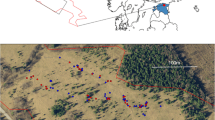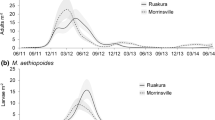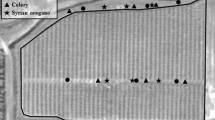Abstract
Insect oviposition on plants is widespread across many systems, but studies on the response of host plants to oviposition damage are lacking. Although patterns of oviposition vary spatially and temporally, ovipositing insects that exhibit outbreak characteristics may have strong effects on host plants during peak abundance. Periodical cicadas (Magicicada spp.), in particular, may reduce the performance of host plants when they synchronously emerge in massive numbers to mate and oviposit on host plants. Here we provide the first experimental manipulation of host plant use by periodical cicadas to evaluate the impact of cicada oviposition on plant performance across a diversity of host species within an ecologically relevant setting. Using a randomized block design, we established a plantation of three native and three exotic host plant species common to the successional forests in which cicadas occur. During the emergence of Brood X in 2004, we employed a highly effective cicada exclusion treatment by netting half of the host plants within each block. We assessed multiple measures of host plant performance, including overall plant growth and the growth and reproduction of individual branches, across three growing seasons. Despite our thorough assessment of potential host plant responses to oviposition damage, cicada oviposition did not generally inhibit host plant performance. Oviposition densities on unnetted host plants were comparable to levels documented in other studies, reinforcing the ecological relevance of our results, which indicate that cicada oviposition damage did not generally reduce the performance of native or exotic host plants.


Similar content being viewed by others
References
Biere A, Honders SJ (1996) Impact of flowering phenology of Silene alba and S. dioica on susceptibility to fungal infection and seed predation. Oikos 77:467–480
Bishop JG (2002) Early primary succession on Mount St. Helens: impact of insect herbivores on colonizing lupines. Ecology 83:191–202
Bouchard M, Kneeshaw D, Bergeron Y (2005) Mortality and stand renewal patterns following the last spruce budworm outbreak in mixed forests of western Quebec. For Ecol Manage 204:297–313
Bouchard M, Kneeshaw D, Bergeron Y (2006) Forest dynamics after successive spruce budworm outbreaks in mixedwood forests. Ecology 87:2319–2329
Braun EL (1950) Deciduous forests of eastern North America, 1st edn. Blackburn, Caldwell, NJ
Carson WP, Root RB (2000) Herbivory and plant species coexistence: community regulation by an outbreaking phytophagous insect. Ecol Monogr 70:73–99
Cook WM, Holt RD (2002) Periodical cicada (Magicicada cassini) oviposition damage: visually impressive yet dynamically irrelevant. Am Midl Nat 147:214–224
Cook WM, Holt RD (2006) Influence of multiple factors on insect colonization of heterogeneous landscapes: a review and case study with periodical cicadas (Homoptera:Cicadidae). Ann Entomol Soc Am 99:809–820
Cook WM, Holt RD, Yao J (2001) Spatial variability in oviposition damage by periodical cicadas in a fragmented landscape. Oecologia 127:51–61
Crawley MJ (1989) Insect herbivores and plant-population dynamics. Ann Rev Entomol 34:531–564
Czarapata E (2005) Invasive plants of the upper Midwest: an illustrated guide to their identification and control. The University of Wisconsin Press, Madison, WI
Davidson DW (1993) The effects of herbivory and granivory on terrestrial plant succession. Oikos 68:23–35
Dybas HS, Davis DD (1962) A population census of seventeen-year periodical cicadas (Homoptera: Cicadidae: Magicicada). Ecology 43:432–444
Dybas HS, Lloyd M (1974) The habitats of 17-year periodical cicadas (Homoptera: Cicadidae: Magicicada spp.). Ecol Monogr 44:279–324
Hogmire HW, Baugher TA, Crim VL, Walter SI (1990) Effects and control of periodical cicada (Homoptera: Cicadidae) oviposition injury on non-bearing apple trees. J Econ Entomol 83:2401–2404
Huntly N (1991) Herbivores and the dynamics of communities and ecosystems. Ann Rev Ecol Syst 22:477–503
Jaenike J (1990) Host specialization in phytophagous insects. Ann Rev Ecol Syst 21:243–273
Kaitaniemi P, Ruohomaki K, Tammaru T, Haukioja E (1999) Induced resistance of host tree foliage during and after a natural insect outbreak. J Anim Ecol 68:382–389
Kanzaki N, Futai K (2006) Is Bursaphelenchus mucronatus a weak pathogen to the Japanese red pine? Nematology 8:485–489
Karban R (1980) Periodical cicada nymphs impose periodical oak tree wood accumulation. Nature 287:226–227
Karban R (1984) Opposite density effects of nymphal and adult mortality for periodical cicadas. Ecology 65:1656–1661
Kauffman MJ, Maron JL (2006) Consumers limit the abundance and dynamics of a perennial shrub with a seed bank. Am Nat 168:454–470
Kneeshaw DD, Bergeron Y (1998) Canopy gap characteristics and tree replacement in the southeastern boreal forest. Ecology 79:783–794
Koenig WD, Liebhold AM (2003) Regional impacts of periodical cicadas on oak radial increment. Can J For Res 33:1084–1089
Lloyd M, White JA (1976) On the oviposition habits of 13-year versus 17-year periodical cicadas of the same species. N Y Entomol Soc 84:148–155
Marlatt CL (1907) The periodical cicada. USDA Bur Entomol Bull 71:1–181
Maron JL, Crone E (2006) Herbivory: effects on plant abundance, distribution and population growth. Proc Roy Soc B 273:2575–2584
Marquis RJ (1984) Leaf herbivores decrease fitness of a tropical plant. Science 226:537–539
Miller FD, Crowley W (1998) Effects of periodical cicada ovipositional injury on woody plants. J Arboric 24:248–253
Naidoo R, Lechowicz MJ (2001) Effects of gypsy moth on radial growth of deciduous trees. For Sci 47:338–348
Nozawa A, Ohgushi T (2002) How does spittlebug oviposition affect shoot growth and bud production in two willow species? Ecol Res 17:535–543
Oberdorster U, Grant PR (2006) Predicting emergence, chorusing, and oviposition of periodical cicadas. Ecology 87:409–418
Powell JA, Logan JA (2005) Insect seasonality: circle map analysis of temperature-driven life cycles. Theor Popul Biol 67:161–179
Root RB (1996) Herbivore pressure on goldenrods (Solidago altissima): Its variation and cumulative effects. Ecology 77:1074–1087
SAS Institute Inc. (2002) SAS. SAS Institute Inc., Cary, NC
Scheiner SM (2001) MANOVA: Multiple response variables and multispecies interactions. In: Scheiner SM, Gurevitch J (eds) Design and analysis of ecological experiments, 2nd edn. Oxford University Press, Oxford, pp 99–115
Smith FF, Linderman RG (1974) Damage to ornamental trees and shrubs resulting from oviposition by periodical cicada. Environ Entomol 3:725–732
Strong DR, Lawton JH, Southwood SR (1984) Insects on plants: Community patterns and mechanisms. Harvard University Press, Cambridge, MA
van der Zwet T, Brown EW, Estabrook P (1997) Effect of periodical cicada injury and degree of fire blight severity on Asian pear cultivars. Fruit Varieties J 51:35–39
Weissling T, Giblin-Davis R, Center B, Heath R, Pena J (2003) Oviposition by Metamasius hemipterus sericeus (Coleoptera:Dryophthoridae:Rhynchophorinae). Fla Entomol 86:174–177
White J, Strehl CE (1978) Xylem feeding by periodical cicada nymphs on tree roots. Ecol Entomol 3:323–327
White JA (1980) Resource partitioning by ovipositing cicadas. Am Nat 115:1–28
White JA (1981) Flagging: host defenses versus oviposition strategies in periodical cicadas (Magicicada spp., Cicadidae, Homoptera). Can Entomol 113:727–738
Williams KC, Simon C (1995) The ecology, behavior, and evolution of periodical cicadas. Ann Rev Entomol 40:269–295
Williams KS, Smith KG, Stephen FM (1993) Emergence of 13-year periodical cicadas (Cicadidae: Magicicada): phenology, mortality, and predators satiation. Ecology 74:1143–1152
Acknowledgments
We thank Keith Clay and Jennifer Rudgers for helpful comments on the experimental design, Joel Olenik, Tyler Droste, and the Indiana University greenhouse staff for assistance in the field, and Angie Shelton, Keith Clay, Kurt Reinhart, Anna Larimer, David Civitello, and Heather Reynolds for reviewing earlier drafts of this manuscript. Funding for this project was provided by NSF grant DEB 0345331 to Keith Clay and by the Indiana University Research and Teaching Preserve. This experiment complied with the current laws of the United States.
Author information
Authors and Affiliations
Corresponding author
Additional information
Communicated by Katherine Gross.
Rights and permissions
About this article
Cite this article
Flory, S.L., Mattingly, W.B. Response of host plants to periodical cicada oviposition damage. Oecologia 156, 649–656 (2008). https://doi.org/10.1007/s00442-008-1016-z
Received:
Accepted:
Published:
Issue Date:
DOI: https://doi.org/10.1007/s00442-008-1016-z




